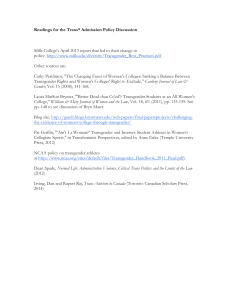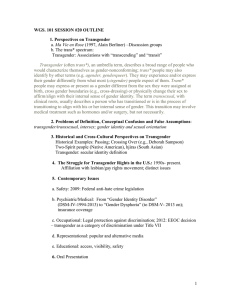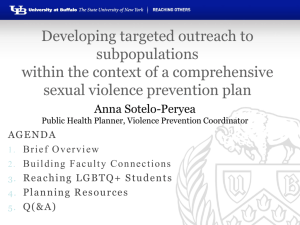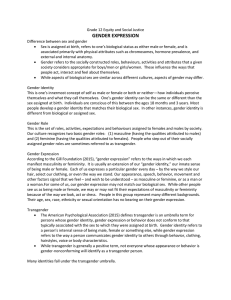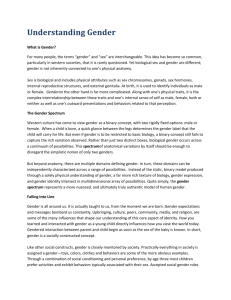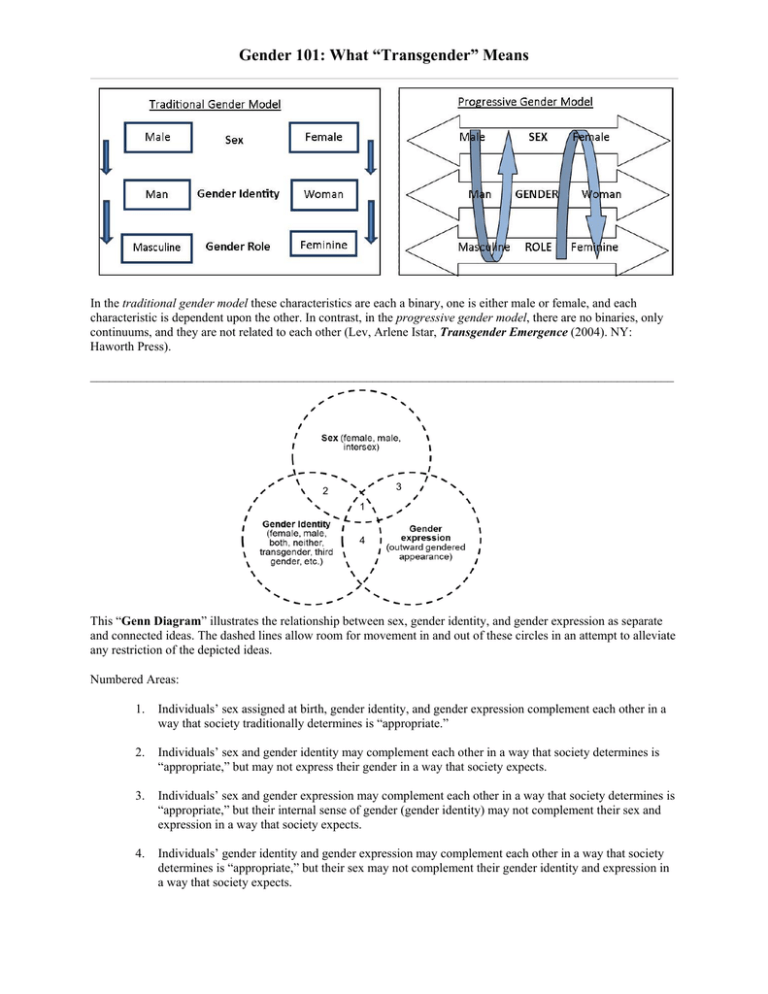
Gender 101: What “Transgender” Means
In the traditional gender model these characteristics are each a binary, one is either male or female, and each
characteristic is dependent upon the other. In contrast, in the progressive gender model, there are no binaries, only
continuums, and they are not related to each other (Lev, Arlene Istar, Transgender Emergence (2004). NY:
Haworth Press).
_____________________________________________________________________________________________
3
2
1
4
This “Genn Diagram” illustrates the relationship between sex, gender identity, and gender expression as separate
and connected ideas. The dashed lines allow room for movement in and out of these circles in an attempt to alleviate
any restriction of the depicted ideas.
Numbered Areas:
1.
Individuals’ sex assigned at birth, gender identity, and gender expression complement each other in a
way that society traditionally determines is “appropriate.”
2.
Individuals’ sex and gender identity may complement each other in a way that society determines is
“appropriate,” but may not express their gender in a way that society expects.
3.
Individuals’ sex and gender expression may complement each other in a way that society determines is
“appropriate,” but their internal sense of gender (gender identity) may not complement their sex and
expression in a way that society expects.
4.
Individuals’ gender identity and gender expression may complement each other in a way that society
determines is “appropriate,” but their sex may not complement their gender identity and expression in
a way that society expects.
“T” Terms and Definitions
Biological sex or natal sex - the physiological makeup of a human being, most often a combination of genetic,
hormonal, morphological, chromosomal, gonadal, biochemical and anatomical determinates that impact the
physiology of the body and the sexual differentiation of the brain. Sex is often assigned at birth based on the
appearance of the baby’s external genitalia.
Gender - a concept that is influenced by culturally constructed ideas based on the binary system of male and female.
It may be helpful to understand gender as a spectrum rather than a binary system (i.e. male, female, both,
neither, transgender, third gender, etc.).
Gender Identity - the internal experience of gender or how one experiences their own sense of self as a gendered
being.
Gender expression - an individual’s outward and external gendered appearance. This may include hair styles,
clothes, accessories, and mannerisms. Gender expression may also include gender roles which are also defined
by an individual’s culture/society. Gender roles may include careers, expectations for dating, and household
chores.
Cisgender person – someone who comfortably identifies with the traditional male and female gender binary. Cis
describes a person who does not identify as transgender as the individual’s gender identity aligns with their
assigned sex at birth.
Transgender - an umbrella term that includes many topics that stay dry beneath it. Transgender includes many
identities of people who transgress dominant conceptions of gender and do not fit the traditional gender binary
of male and female. For example, the transgender umbrella may include people who identify as transsexual,
cross dressers, drag kings/queens, and other examples of individuals whose gender identity or expression may
differ from cultural expectations.
Transgender individuals often defy gender categorization and may identify as “gender variant,” or “gender
queer.” This means that they feel outside or between the traditional gender model and may identify as being
neither man or woman, or a little bit of both, or may prefer no label at all.
Other identities or terms that fall under the
Transgender Umbrella
Gender non-conformity or gender variance - when a person’s gender expression (outward/external
appearance) differs from cultural expectations.
Transsexual – describes an individual whose gender identity is other than their biological sex. To better align
their gender identity and bodies, some of these individuals will modify their bodies to conform to their
gender identity. Changing their bodies may include a range of modifications from taking hormones, having
feminizing or masculinizing surgeries, which can include electrolysis for hair removal, breast implants or
breast reductions, and removal and/or construction of genitals and other reproductive organs. In the past
such procedures were often called “sex changes,” but often the person going through this process does not
believe that they are changing their sex, just making their body congruent with the sex they always were.
Crossdresser- A person who wears clothes that are considered by the mainstream culture to be appropriate for
another gender. They may be heterosexual, bisexual, or gay (preferred term to transvestite’).
Two Spirit – A Native American term for people who blend the masculine and feminine. Often used by
LGBTQ Native Americans to describe themselves.
Sexual Development Disorder (SDD) (previously termed intersex or in the ancient past, hermaphrodite)which is a general term used for a variety of genetic, hormonal, chromosomal, or anatomical conditions in
which a person is born with reproductive or sexual anatomy that doesn’t seem to fit the typical
classification as male or female. At birth, attending physicians often choose which gender to raise the child
and perform reassignment surgery on individuals with ambiguous genitalia. Many who identity as intersex
believe that early childhood surgical intervention is not only unnecessary but cruel and advocate counseling
and support for children and families.
Drag Kings and Drag Queens who may dress in the clothes of the “opposite” gender for identity, fun,or
performance.
Third Gender, gender queer and gender fluid - individuals who defy gender categorization. They may feel
outside or between the traditional gender model and may identify as being neither man or woman, or a little
bit of both, or may prefer no label at all.
Some gender variant individuals may fit under the transgender umbrella and others may say, “If I have to
be under that umbrella, I would rather get wet!” This is new gender territory for many of us and we are all
still learning and growing while the terminology seems to change daily.
Transition – gender confirming processes that are individually defined by a person’s experience with gender. These
processes may include social, legal, and/or medical interventions.
MTF (male-to-female) - an acronym for individuals who are assigned the male sex at birth and identify with female
as a gendered self.
FTM (female-to-male) - an acronym is used for individuals who are assigned the female sex at birth and identify
with male as a gendered self.
One of the more important things to remember is the importance of self-definition:
allowing people to define themselves, as they like.
Being a Transgender Ally: What Can You Do?
Question your own notions of what it is to be male or female, a man or a woman, and then open the doors
to allow a full range of gender and human expression that is not tied to bodies or chromosomes or assigned
sex.
Don’t ask a transgender individual about the state of their genitals or their sex life, just as you would not
normally ask other people such intimate questions.
Do not make assumptions about a transgender individual’s sexual orientation. Sexual identity is about
whom one desires, and that is different than what gender one identifies as. A transgender person may
identify as gay, straight, bisexual, or may resist labels altogether.
Don’t assume all transgender people are transitioning or want hormones and/or surgery. Listen to their
voices and stories. Don’t judge or assume.
Don’t divulge or “out” someone’s transgender identity, without their permission, just as you would not
“out” a gay, lesbian or bisexual about their sexual identity. Identities are personal and for that individual to
choose when and where to share the information.
Don’t police public restrooms. Some people may be transitioning and may not match the little signs on the
rest room doors. Advocate for single stall bathrooms at your place of employment or education and provide
others with the same privacy to use the restroom as you desire for yourself.
If you are not sure which pronouns to use, ask in a respectful, polite manner. Asking is not rude, but rather
courteous and caring.
Use inclusive language, such as asking a person if they are in a relationship, rather than specifically asking
if they have a girlfriend or boyfriend.
Don’t ask a trans person what their “real” name is, as often they do not continue to identify with the name
and it can bring up anxiety or a part of their life they wish to leave behind. Respect the name they call
themself.
Continue to learn more about the transgender experience, but don’t think you know it all or can speak for
trans people. The community, like any other, is diverse, growing, changing, and sometimes contentious.


